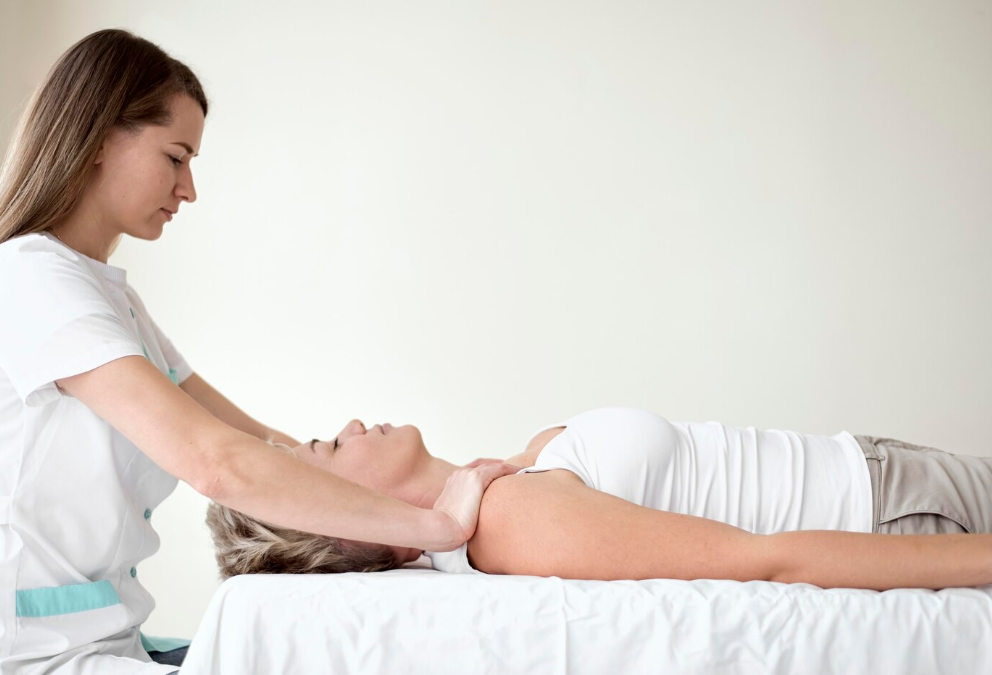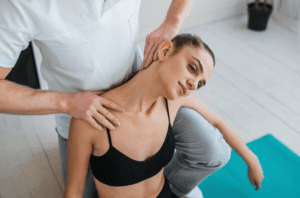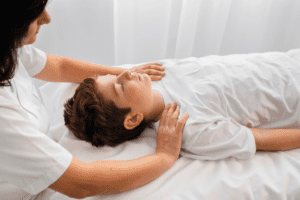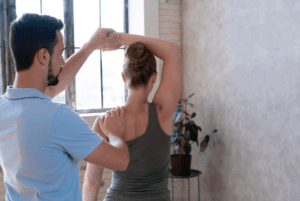What’s your move when pain pays a visit? You stretch out your hand. Your hand instinctively finds the source of discomfort and soothes it with a gentle massage. Mastering acupressure enhances self-massage, bringing relaxation and relief to chronic pain.
Acupressure, rooted in ancient Chinese medicine, has stood the test of time for over 2,000 years. It’s a magical way to awaken the body’s healing powers and ease suffering. Just like acupuncture, acupressure taps into the body’s meridians or pressure points, but without the needles.
Does it work? The answer is a resounding yes! A review indicated that acupressure was successful in lowering pain in nine out of ten trials. This ancient pain management method has proven its worth for over 2,000 years.
Are you trying to find a better way to receive massage therapy in Vancouver? The efficiency of your sessions may be significantly increased by being aware of and addressing pressure spots. We will discuss pressure points in this book, along with helpful hints and techniques to help you get the most out of massage therapy in Vancouver.
What are Pressure Points?
A variety of therapeutic benefits can be elicited by stimulating particular locations on the body known as pressure points. These locations are said to be associated with various bodily systems, energy channels, and organs. Massage therapists may unleash these regions’ ability to promote relaxation, alleviate pain, and enhance general well-being by applying appropriate pressure to them.
The body’s pressure points correspond to the acupressure sites utilised in traditional Chinese medicine. Certain locations were identified by traditional practitioners as having better energy flow across the body. Even though scientists haven’t looked into the methods or effectiveness of these medicines, people still use them today.
Pressure points on the body are certain places that, when applied pressure or massage, can assist in the release of tension and enhance blood flow, either in the targeted location or in other parts of the body. There are pressure spots all throughout the body, and in order to maximise their benefits, you need to use certain techniques.
It’s true that you can work on your massage pressure points at home! Even while a professional massage therapist—like one who does mobile massage therapy in Atlanta—will provide a more thorough massage, you can still utilise the methods listed below to get immediate relief from sore, achy muscles.
How Does Acupressure Work?
Acupressure practitioners apply pressure to the body’s meridians’ acupoints using their fingers, palms, elbows, feet, or specialised tools. In addition to other techniques, acupressure occasionally includes stretching or acupressure massage.
On a supple massage table, you lie completely clothed for an acupressure treatment. The acupressure spots on your body are softly pressed by the practitioner. Usually, a session lasts for one hour. For optimal results, many sessions could be required.
Restoring health and harmony in the body’s energy pathways and balancing the opposing energies of yin (negative energy) and yang (positive energy) are the aims of acupressure and other Asian bodywork techniques. Acupressure’s proponents assert that in addition to treating the body and energy fields, it also heals the mind, emotions, and soul. Some people even think that therapists have the ability to transfer external qi, or life force, to another individual.
Not all Western practitioners think that these meridians exist at all, much less that this is conceivable. Rather, they blame other variables for any outcomes, such as lessened tenseness in the muscles, enhanced blood flow, or the release of endorphins, which are organic analgesics.
What Are Common Acupuncture Points?
The body has too many acupuncture sites to list, numbering in the hundreds. The following three are frequently employed by acupressure and acupuncturists:
- You may find the fourth large intestine (LI 4) in the fleshy, pliable space between your index and middle fingers.
- The third liver, or LR-3, is situated on the very top of your foot, just above the joint that connects your big toe to the toes.
- You may find Spleen 6 (SP-6) around three finger widths above the inside of your ankle.
What is the Right Way to Massage Your Pressure Points?
Being persistent and patient is key when doing self-massage with acupressure. Although results might not be felt right away, getting frequent massages can lessen discomfort and the chance that it will return.
As you apply acupressure:
- Give yourself a few minutes.
- Choose a comfortable position to sit or lie down.
- Breathe deeply, close your eyes, and relax.
- Apply intense, firm pressure while making a little up-and-down or rotating motion.
For Pain in the Shoulders

Tension headaches, often known as neck and shoulder discomfort, are frequently the consequence of stress. There are a few pressure sites that may be utilised to relieve shoulder discomfort, starting with one of the more popular ones.
The first, and simplest to locate, is situated between the thumb’s web and the first finger.
- Apply pressure firmly until you get a slight soreness.
- Tent for a duration of five seconds.
- Repeat three more times after releasing.
For Pain in the Lower Back
There are two primary pressure areas that may be used to treat lower back pain. First, it’s around your waist:
- As you stand up, gently place both hands around your waist so that your thumbs are wrapped around your back.
- Holding your thumbs firmly in place, move them in a circular manner for five seconds.
- Do this three times over.
You may also locate a pressure point halfway up your calf muscle to treat low back pain:
- Hold for five seconds with the same circular motion and pressure.
- Let go and do it twice more.
About Sinus Pain
The first place to start alleviating sinus discomfort and pressure is just between your eyebrows. It is advisable applying pressure here for five seconds in a circular motion with your thumb or index finger.
- Make the same circular motion as previously to reach the second point, which is at your temples.
- Tracing your fingers from your temples to each side of your nose is a third approach. Apply pressure here for five seconds in a circular manner.
- For each of the pressure locations, Moreau advises using this pressure method, making the pressure strong but not unpleasant.
Which Medical Conditions Can Acupressure Help?
The study of acupressure’s health advantages is still in its infancy. Its use for various health issues is supported by several patient accounts. However, more carefully planned study is required. Acupressure seems to help with the following health issues:
1. Nausea:
A number of studies have shown that applying pressure to certain points on the wrist might help with nausea and vomiting:
- After surgery
- When under spinal anesthesia
- After chemotherapy for pregnancy-related motion sickness
On the inside of the wrist, between the two major tendons that begin at the base of the palm, lies the PC 6 acupressure point. Specialty wristbands are available for purchase over the counter. Some find that these provide pressure on comparable pressure spots.
2. Cancer:
Some studies state that acupressure not only helps with nausea immediately following chemotherapy but also with stress reduction, energy enhancement, pain relief, and other symptoms related to cancer or its therapies. To verify these reports, more investigation is required.
3. Distress:
Acupuncture may be beneficial for headaches, post-operative pain, and lower back pain, according to some preliminary research. The pain of other conditions may also be relieved. The LI 4 pressure point is occasionally used to treat headaches.
4. Arthritis:
According to some research, acupressure may assist with some forms of arthritis by promoting the production of endorphins and anti-inflammatory effects.
5. Anxiety and depression:
Numerous studies indicate that using acupressure might help with tiredness and mood. To be sure, better trial designs are required.
Do Pressure Points Work?
There is considerable opposing clinical data available about the efficacy of pressure point massage. While some research has shown pressure points to be useful in treating certain ailments, other studies have not. Still, the study is being done.
When acupressure is used in conjunction with other therapies as a supplemental therapy, it is frequently the most successful.
The following are some recent studies that discuss the therapeutic efficacy of pressure point self-massage, reflexology, and acupressure for certain conditions:
- A study of the literature revealed that acupressure and acupuncture worked well as additional therapies for patients with persistent migraines. Over the course of many months, the number and intensity of migraines reported by participants who received acupuncture or acupressure decreased. To lessen their discomfort, they also need less painkillers.
- According to one study, auricular (ear) acupressure and acupressure for breast cancer patients reduced the weariness and sleeplessness associated with chemotherapy.
- According to a study analysis, those who regularly had pressure point massages reported feeling less anxious and in discomfort.
Are There Any Precautions With Acupressure?
Acupressure is generally quite safe. Before attempting any therapy that involves manipulating joints and muscles, like acupressure, make sure to discuss it with your doctor if you have cancer, arthritis, heart disease, or any other chronic illness. Additionally, confirm the licensure and certification of your acupressure practitioner.
If any of the following situations describe you, you may need to avoid deep tissue therapy, such as acupressure:
- If there is a malignant tumor nearby or if the cancer has gone to the bones, therapy is administered.
- You suffer from a bone condition, rheumatoid arthritis, or a spinal injury that might deteriorate with manual manipulation.
- Your veins are varicose.
- You are carrying a child (because some spots may produce contractions).
Tips and Tricks for Targeting Pressure Points
- It’s All About Communication: Discuss any particular sore spots or concerns you may have with your registered massage therapist (RMT) prior to your massage therapy appointment in Vancouver. They can then concentrate on the pertinent pressure areas to meet your specific demands.
- Selecting the Proper Spa or RMT: Make sure you choose a reputed spa or a licensed massage therapist with a pressure point understanding while looking for massage therapy in Vancouver. Seek experts and people with relevant experience and knowledge.
- Investigate Various Methods: Pressure points are the specific focus of several massage treatments, including reflexology, acupressure, and shiatsu. Talk to your Vancouver RMT about these choices to find the approach that best suits your needs and preferences.
- Take Care of Yourself in Between Sessions: In between massage therapy appointments, think about engaging in self-care to maximise the advantages of targeted pressure points. This may be utilising a foam roller, doing some light stretching, or placing hot or cold packs on particular spots.
- Remain Hydrated: Getting lots of water before and after your massage therapy session in Vancouver will aid in the removal of toxins that were generated during the procedure, which can enhance your general health.
Recall that although pressure points have the potential to greatly enhance well-being, it is crucial to speak with a Vancouver licensed massage therapist to guarantee proper and safe use.
Also read: Is a Deep Tissue Massage What Your Muscles Need?
Final Thoughts
Tension and stress are frequently the root causes of discomfort sensations such as those mentioned above. For these strategies to work as well as possible, you should learn to relax and cut back on stressors in your life. Asking a friend or relative for assistance is always an option if you’re having trouble unwinding while also doing self-massage.
You may maximise the advantages of this age-old healing method by combining pressure point awareness and targeting into your massage therapy sessions in Vancouver. Specialising in pain alleviation, stress reduction, circulation improvement, and energy flow enhancement, a qualified massage therapist at Spa Utopia can assist you in realising the benefits of these pressure points.
Why not discover more about pressure points and the benefits of massage in Vancouver right now?
FAQs
1. What are pressure points and how do they work?
Pressure points, also known as acupressure points, are specific points on the body that are believed to be connected to energy channels called meridians. When these points are stimulated, it is thought to release blockages in the flow of energy, which can help to relieve pain, improve circulation, and promote relaxation.
2. How can I find pressure points?
There are many resources available to help you find pressure points. You can find diagrams and charts online or in books. You can also ask an RMT to show you how to find specific pressure points. Some general tips for finding pressure points include:
- Look for tender or sensitive spots on the body.
- Feel for a slight indentation or bump.
- Use a pressure point chart to guide you.
3. How much pressure should I apply to pressure points?
You should apply firm but gentle pressure to pressure points. You should not feel any pain, but you should feel a slight sensation of pressure. If you apply too much pressure, you may damage the tissue. A good rule of thumb is to use the same amount of pressure that you would use to massage a sore muscle. If you are unsure of how much pressure to apply, start with light pressure and gradually increase it until you find the level that is most comfortable for you.
4. How long should I massage pressure points?
You should massage pressure points for 30-60 seconds each. You can repeat as needed, but it is best to wait at least a few hours between treatments to avoid overstimulating the area. If you are new to massaging pressure points, start with shorter sessions and gradually increase the duration as you become more comfortable. You can also massage multiple pressure points at once, but it is important to listen to your body and stop if you feel any discomfort.
5. What should I do after massaging pressure points?
After massaging pressure points, it is important to drink plenty of water to flush out toxins and promote healing. You may also want to take a warm bath or shower to relax your muscles. You should also avoid strenuous activity for a few hours after massaging pressure points. This will give your body time to rest and recuperate. If you are experiencing any pain or discomfort after massaging pressure points, it is important to stop and consult with an RMT or other healthcare professional.





